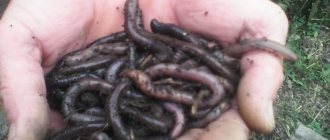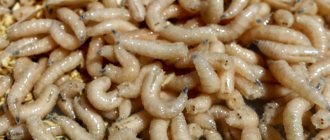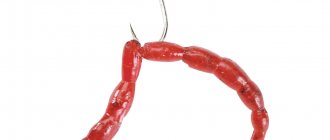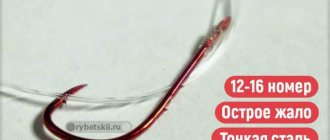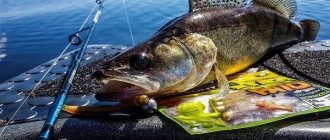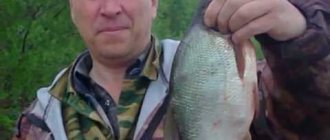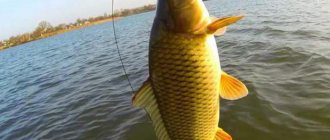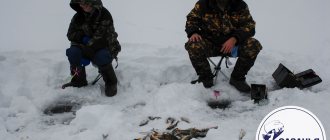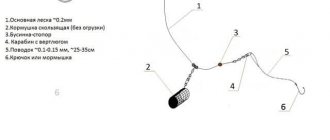What worms are used for fishing
Different individuals practice, there are no significant differences between them. The underwater inhabitant pecks at everyone with equal pleasure, but it is still useful to know about the classes of protostomes:
- dung - the thinnest worm for bait, red;
- earthen - larger than the previous one, has a rich pink body. Thanks to its density, it can withstand several bites;
- subleaf – thicker than those listed above, the body is dark red, sometimes with a purple or blue tint. Attractive to fish;
- rain, or creep, is the largest specimen, some individuals reach 20 cm in length and 8 in volume..
Any will be a good choice if you are looking for a universal bait or the basis for a good groundbait.
Where to dig for worms?
They live in different places, for example, the distribution area of dung is clear from the name - it is better to look in dung heaps or under them. The earthworm can be found in moist soil, where it lives at a relatively shallow depth, up to 20-30 centimeters. The underleaf does not have such a muscular body, which means it cannot dig into the ground, and can often be found crawling under damp leaves. Finally, experienced fishermen collect the earthworm after the rain, when it crawls out onto dry paths from flooded burrows, which is why it received its second name - crawl.
To learn more:
Rating of the best wobblers for pike
Nursery for future bait
In order to always have fresh bait on hand, without going out to look for it and without having to adjust to the weather, many people set up a “factory” for producing worms in their summer cottage or in the courtyard of their house. To do this, you need to dig up a small plot of land, adding armfuls of leaves and weeds, old bags. Then launch several dozen worms. It is good to regularly water the “bed” with water, and feed the pets with food waste. After a month you can use them.
Those who do not have a piece of land for a nursery can set it up in the garage, basement or hallway. The main condition is low air temperature. You will need a spacious wooden box, into which you should pour in layers: sand mixed with soil, damp leaves on it, and on top of everything - a mixture of soil and leaves. Throw worms into the prepared substance and cover the box with burlap. Further actions include regular watering and feeding of the inhabitants.

Breeding worms
To prepare your own bait, you need to make dense compost. It is necessary to dig a ditch 30-40 cm deep. It should be slightly damp and in the shade. Then you need to prepare the soil by covering it with 15 cm of clay, compact it and sprinkle it with a layer of earth with humus. Birch leaves are laid on top.
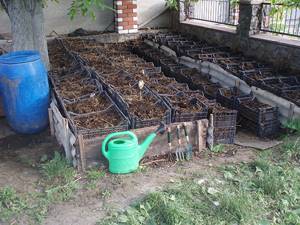
It is best to prepare compost in the fall so that the worms are ready for fishing in the spring. Before the onset of winter, it is necessary to check the density of the compost. It is necessary to periodically add substances that promote rotting.
Note! Do not add ash or coal to compost, as they are contraindicated for worms. Manure additions are also not recommended if earthworms are being raised. Shredded wood, but not impregnated with any chemicals, is suitable for loosening the soil.
Worms need to be fed periodically. Suitable feed types:
- potato peel;
- sawdust;
- used tea leaves.
It is extremely important to prevent salt from entering the food, as this will guarantee the death of the worms.
The video will help you better understand how to prepare worms yourself.
What kind of fish can be caught with a worm?
The advantage of this bait is that it is universal. It is enough to know how to properly place a worm on a hook to feel like an experienced fisherman. Of course, it makes no sense to use it when fishing with a lure or spinning rod. But if you have to fish with a float rod, donka or jig, it’s not easy to find better bait. Having worms in your arsenal, you can count on a rich catch of any fish:
- small and medium: sprat, grayling, gudgeon, bleak, crucian carp, silver bream;
- large: chub, small catfish, carp or carp, bream;
- predatory: perch, pike perch, small pike, and when baited in a bunch - burbot.
Preparation
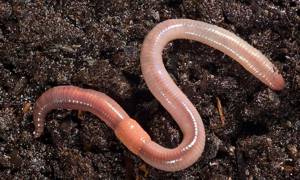
The preparation of any worms for fishing must be of a certain nature. It is worth keeping in mind that when a person digs up worms and then immediately goes fishing with them, this reduces the biting success by about a third. For fishing for bream, carp, perch and other fish, you need to prepare worms in advance. The cleaning process is carried out on average one day before fishing.
Speaking about how to prepare worms for fishing at home, it should be said that it all starts with digging. There are various recipes on the forums for preparing delicious worms. You should keep them if the fisherman wants to get a good catch.
You can use:
- a piece of rag, definitely cotton;
- a spoonful of sugar;
- vanillin in a 2 gram bag;
- tea leaves;
- melt water;
- anise, lemon balm, mint, dill, thyme and other herbs of the fisherman’s choice.
It is recommended to use grass that grows in the pond where fishing occurs.
When pointing out how to prepare worms for fishing, you need to take into account that after digging it up, you cannot immediately put it in a jar made of glass. This especially applies to the hot season. This is due to the fact that the worm will not withstand such heat and the fisherman will be left without bait. In addition, the fish will not bite on such a worm. Preparing worms before fishing using the ingredients in question involves first placing a spoonful of sugar in a container and pouring in vanillin. Next, moisten it a little and mix. The rag is well wetted in melt water and wrung out. You need to spread newspaper or use paper. The correct thing to do next is to use tweezers and remove the earthworms or dung worms from the jar one at a time. They are placed on a damp cloth, having previously been cleared of soil.
The worms are then soaked in a mixture made from sugar and vanillin. The grass is also laid out on the worms, then everything is wrapped in a rag and placed in a box. Such bait for crucian carp and other fish should be prepared for about 12 hours or a day. As a result, the worms come out with the smell of grass, elastic and mobile, which will ensure a good bite.
Feeding with worms
The worm is a universal fishing assistant. It is used not only as bait, but also in the preparation of feeding, when it acts as a base and flavoring agent. For example, you can boil peas, pearl barley or corn and add chopped worms to them. Thanks to this, the fish will find the bait faster even in muddy water, which guarantees a rich catch. Live worms are also used in another way.
To learn more:
Review of Kosadaka wobblers for pike and perch
Cut a piece of turf with grass measuring 30x30 centimeters, place it in a small net like a string bag and sprinkle a handful of worms on top. Leave them for a few minutes to burrow into the ground. Carefully lower the bag into the water at your fishing spot. Greenery attracts fish, and crawling worms will interest them. But since there are few of them and they are not chosen often, the fish will not get full ahead of time and will not lose interest in the bait.
Why are Californian worms bred?
Like other earthworms, Eisenia Foetida and Eisenia Andreii species are widely used in vermicomposting. Currently, they make up approximately 80% of the total number of earthworms used for industrial purposes and in large quantities. Such popularity of the Californian worm is due to the fact that it only needs biomaterial rich in organic matter to feed on it and practically does not need to use deep soil.
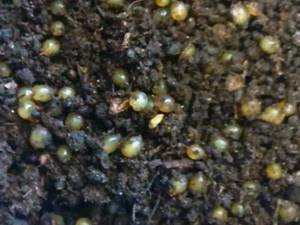
California worm cocoons
In addition to using California red worms for vermicomposting, they can be raised as feed for pets, poultry and fish. As food, worms can be used both live and specially processed by drying or steaming. When adding worm biomass to feed, its nutritional value increases by almost a quarter.
In addition to being added to feed, worms are processed into special protein flour containing up to 67% pure protein. The remaining components are fats -20%, methionine -3% and lysine - 8%. Such protein flour is one of the most nutritious and effective components for the formulation of food and combined feeds.
The California worm is used as fishing bait. The bright color and pungent smell attract fish well and awaken their appetite.
Storing and preparing worms
Knowing the simplest rules, you can be sure that the bait will remain fresh and appetizing for a long time:
- Worms should not be kept in an iron container - it quickly heats up in the sun, which is why the bait deteriorates and acquires a metallic smell that can scare away wary fish.
- Try not to mix dung worms with others in one jar - they secrete a caustic liquid that kills their neighbors. and those, accordingly, begin to decompose and poison dung. The best container is a thick canvas bag; it does not heat up and is ventilated. The main thing is to remember to occasionally wet its surface.
- On the eve of going to a lake or river, sort out the bait, remove the spoiled one, and place it in a container with sea sand for a day (if you can get it). The worms will clean themselves and become elastic. But you can’t leave them in the sand for a long time - they will die of hunger. Just before fishing, spray the bait with a few drops of unrefined sunflower oil.
- It is better to store the crawling in a container where damp moss is placed.
How to breed crawling worms
In nature, these worms live in the soil, where there are remains of plant organic matter, which serves as their food. By digesting the soil, they convert it into nutritious humus. Due to the underground passages they make while moving, air exchange in the ground is activated. Experienced gardeners have long discovered improved plant growth in earthworm habitats.
Related article:
Carefully! 7 poisonous plants in the garden that you need to watch out for
So, if you intend to create a worm hutch for breeding crawlers, you need to choose a warm, sunny day for this. First you will have to dig a trench and fill it with garden soil mixed with rotten leaves and humus. Within 3-4 days you will find several worms in it.
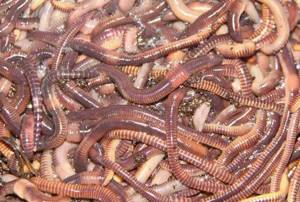
Create a wormhole
Important! When you build a worm hutch, make sure that no ashes or coals fall on the ground, otherwise the crawlies will not actively develop.
During the cold season, you can grow worms in a barn, in a basement, or on a balcony. The main thing is that the room temperature is at least +15°C. The construction diagram of the worm house is as follows:
- Take a box no more than 20 cm deep. It is advisable that it be made of wood and have gaps on the sides.
- Place material with breathable properties on its bottom. Burlap or lutrasil are ideal.
- Make a mixture of soil, chopped hay and leftover leaves. Pour it into a container.
- Moisten the substrate and place 2-3 dozen individuals on its surface.
Related article:
5 useful tips for arranging a small dacha that will help expand the boundaries of the site
You will definitely have to control the soil moisture and from time to time add plant debris and other food that the individuals eat into the “house”.
Advice. Try to mix the soil in the box from time to time. Such an event will contribute to the uniform distribution of moisture and feed. Moreover, the worms will be deprived of the opportunity to bunch into balls, which is why they die.
Basic rules for planting
It is important to know how to properly place a worm on a hook. There are several methods depending on what kind of fish you are going after.
The most common method is the “toe” method: pierce one end of the worm with a hook and gently pull it. Carefully tear off the long tip. This is suitable if you plan to catch small and medium-sized fish that have the habit of nipping off a piece of bait. When using a crawler, do not pull it too hard; its soft body breaks easily.
To learn more:
Rattlins for ice fishing for pike perch: top 5
How to properly place a worm on a hook when catching large fish?
In this case, you need to carefully string it, piercing it in the middle and leaving both ends dangling. But make sure that there are no small fry in the future bite area - it will quickly fray the bait. But a large fish, attracted by the bait moving in the current, will grab it without hesitation. If you are fishing with a double or just a large hook, you can use several worms at once. The method is effective when fishing for burbot, pike and large perch; bloodworms are also used. The main thing is to make sure that the sting of the hook is hidden - having accidentally pricked itself on it, the most desirable specimens usually immediately swim away in fear.
